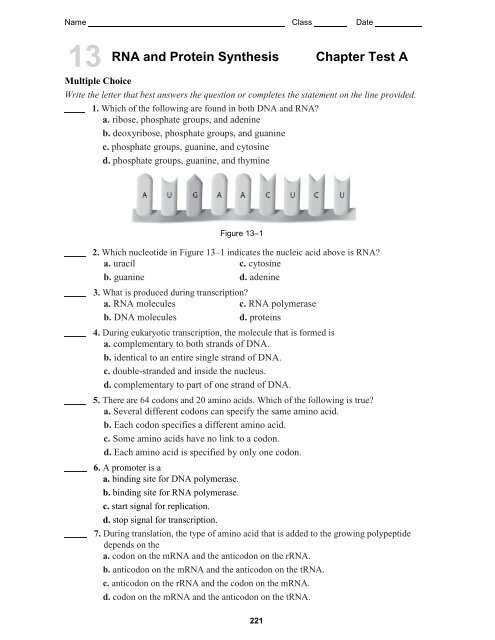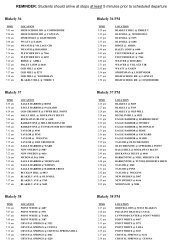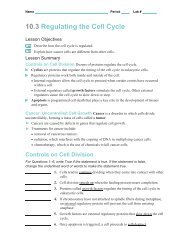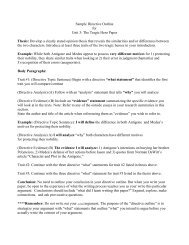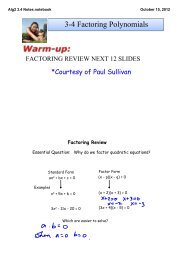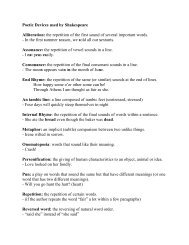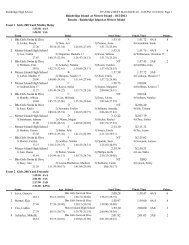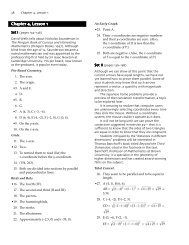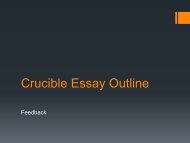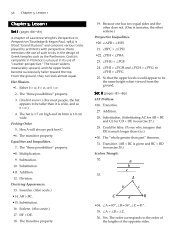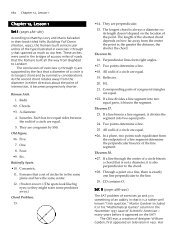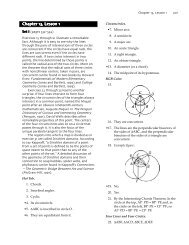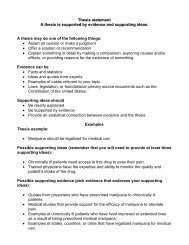RNA and Protein Synthesis Chapter Test A
RNA and Protein Synthesis Chapter Test A
RNA and Protein Synthesis Chapter Test A
Create successful ePaper yourself
Turn your PDF publications into a flip-book with our unique Google optimized e-Paper software.
Name Class Date<br />
13<br />
Multiple Choice<br />
<strong>RNA</strong> <strong>and</strong> <strong>Protein</strong> <strong>Synthesis</strong><br />
<strong>Chapter</strong> <strong>Test</strong> A<br />
Write the letter that best answers the question or completes the statement on the line provided.<br />
1. Which of the following are found in both DNA <strong>and</strong> <strong>RNA</strong><br />
a. ribose, phosphate groups, <strong>and</strong> adenine<br />
b. deoxyribose, phosphate groups, <strong>and</strong> guanine<br />
c. phosphate groups, guanine, <strong>and</strong> cytosine<br />
d. phosphate groups, guanine, <strong>and</strong> thymine<br />
2. Which nucleotide in Figure 13–1 indicates the nucleic acid above is <strong>RNA</strong><br />
a. uracil c. cytosine<br />
b. guanine d. adenine<br />
3. What is produced during transcription<br />
a. <strong>RNA</strong> molecules c. <strong>RNA</strong> polymerase<br />
b. DNA molecules d. proteins<br />
4. During eukaryotic transcription, the molecule that is formed is<br />
a. complementary to both str<strong>and</strong>s of DNA.<br />
b. identical to an entire single str<strong>and</strong> of DNA.<br />
c. double-str<strong>and</strong>ed <strong>and</strong> inside the nucleus.<br />
d. complementary to part of one str<strong>and</strong> of DNA.<br />
5. There are 64 codons <strong>and</strong> 20 amino acids. Which of the following is true<br />
a. Several different codons can specify the same amino acid.<br />
b. Each codon specifies a different amino acid.<br />
c. Some amino acids have no link to a codon.<br />
d. Each amino acid is specified by only one codon.<br />
6. A promoter is a<br />
a. binding site for DNA polymerase.<br />
b. binding site for <strong>RNA</strong> polymerase.<br />
c. start signal for replication.<br />
d. stop signal for transcription.<br />
Figure 13–1<br />
7. During translation, the type of amino acid that is added to the growing polypeptide<br />
depends on the<br />
a. codon on the m<strong>RNA</strong> <strong>and</strong> the anticodon on the r<strong>RNA</strong>.<br />
b. anticodon on the m<strong>RNA</strong> <strong>and</strong> the anticodon on the t<strong>RNA</strong>.<br />
c. anticodon on the r<strong>RNA</strong> <strong>and</strong> the codon on the m<strong>RNA</strong>.<br />
d. codon on the m<strong>RNA</strong> <strong>and</strong> the anticodon on the t<strong>RNA</strong>.<br />
221
Name Class Date<br />
8. What is an exception to the central dogma of molecular biology<br />
a. Viruses sometimes transfer information from <strong>RNA</strong> to DNA.<br />
b. Viruses sometimes transfer information from DNA to <strong>RNA</strong>.<br />
c. Viruses sometimes transfer information from proteins to DNA.<br />
d. Viruses can translate without <strong>RNA</strong>.<br />
9. In eukaryotes<br />
a. Transcription takes place in the cytoplasm, <strong>and</strong> translation takes place in the nucleus.<br />
b. Transcription takes place in the nucleus, <strong>and</strong> translation takes place in the cytoplasm.<br />
c. Transcription <strong>and</strong> translation both take place in the nucleus.<br />
d. Transcription <strong>and</strong> translation both take place in the cytoplasm.<br />
10. Which of the following is the name of a type of chromosomal mutation AND a type of gene<br />
mutation<br />
a. substitution c. deletion<br />
b. insertion d. inversion<br />
11. What are some characteristics of polyploidy plants<br />
a. They tend to be weaker <strong>and</strong> smaller than diploid plants.<br />
b. They tend to be bigger <strong>and</strong> stronger than diploid plants.<br />
c. They tend to be weaker, but bigger than diploid plants.<br />
d. They tend to be smaller, but stronger than diploid plants.<br />
12. A lac repressor turns OFF the lac genes by<br />
a. binding to the promoter. c. binding to the operator.<br />
b. DNA polymerase. d. binding to the lac genes.<br />
13. Gene regulation in eukaryotes<br />
a. usually involves operons.<br />
b. is simpler than in prokaryotes.<br />
c. allows for cell specialization.<br />
d. includes the action of an operator region.<br />
14. What regulates the expression of most eukaryotic genes<br />
a. mi<strong>RNA</strong> c. dicer enzymes<br />
b. transcription factors d. silencing complexes<br />
15. Hox genes<br />
a. determine when bacteria replicate their chromosome.<br />
b. determine where the flagellum is on a bacterium.<br />
c. determine when a dog’s cells replicate their DNA.<br />
d. determine the location of a dog’s ears.<br />
222
Name Class Date<br />
Completion<br />
Complete each statement on the line provided.<br />
16. A eukaryotic gene consists of regulatory regions, a(n) ____________________, <strong>and</strong> the nucleotide<br />
sequence that is transcribed.<br />
17. Insertions <strong>and</strong> deletions that change the entire genetic message that comes after the mutation are<br />
called ____________________.<br />
Normal<br />
Chromosome<br />
Mutant 1<br />
Figure 13–2<br />
Mutant 2<br />
18. Mutant 1 in Figure 13–2 is the result of a(n) ________________ because part of the chromosome<br />
reverses direction.<br />
19. The element bromine can cause a genetic change, so bromine is called a _____________.<br />
20. A mutation in a series of genes called ____________________ can change the organs that develop<br />
in specific parts of an embryo.<br />
Short Answer<br />
In complete sentences, write the answers to the questions on the lines provided.<br />
21. What might be the effect of a mutation in the promoter sequence of a gene<br />
22. According to Figure 13–3, what codons specify<br />
glycine<br />
23. What happens to lac repressors in E. coli when<br />
lactose is present<br />
24. How does micro<strong>RNA</strong> (mi<strong>RNA</strong>) function to help<br />
block gene expression<br />
Figure 13–3<br />
223
Name Class Date<br />
<strong>Protein</strong> <strong>Synthesis</strong><br />
Figure 13–4<br />
23. Describe the functions of the three kinds of <strong>RNA</strong> illustrated in Figure 13–4.<br />
24. What happens to lac repressors in E. coli when lactose is present<br />
25. How does mi<strong>RNA</strong> function to help block gene expression<br />
Using Science Skills<br />
Use the diagram below to answer the following questions on the lines provided.<br />
Figure 13–5<br />
224
Name Class Date<br />
28. Interpret Visuals What is structure E in Figure 13–5 What does it specify<br />
29. Predict What would happen to structure F in Figure 13–5 if structure C were deleted<br />
30. Predict In Figure 13–5, what effect would the deletion of structure C have on the process that<br />
occurs during step Y<br />
Essay<br />
Write the answer to each question in the space provided.<br />
31. Contrast the functions of the three main types of <strong>RNA</strong>.<br />
32. Explain the process of translation.<br />
225
Name Class Date<br />
33. Why do some kinds of point mutations generally result in greater changes in proteins than others<br />
34. What might be the effects of a mutation in the gene that codes for the lac repressor in E. coli<br />
35. Why is gene regulation necessary in the development of multicellular organisms Use a specific<br />
example to support your argument.<br />
226


